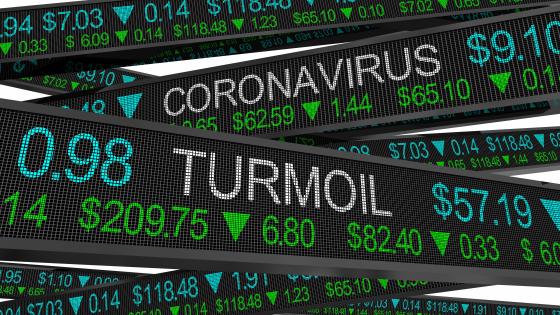Is the COVID-19 pandemic just an extraordinarily large recessionary shock, after which economies will go ‘back to normal’, or rather the trigger of a ‘Great Reallocation’ of capital and labour, which will radically reshape our societies for years to come? There is increasing evidence that the latter is the correct answer, even though we are still only starting to guess the end result. Based on firm surveys and labour market data, Barrero et al. (2020) estimate that 42% of the gross staffing reductions triggered by the COVID-19 shock in the US “will result in permanent job losses”, yielding an estimate of 11.6 million permanently lost jobs, without including future job losses caused by the COVID-19 shock. They conclude that “the reallocative consequences of the COVID-19 pandemic will continue to play out for many months and years to come”.
The mirror image of this impending Great Reallocation can be glimpsed in the heterogeneous response of asset prices to the COVID-19 shock: investors have shown growing awareness of the wide differences in firms’ ‘resilience’ to the COVID-19 pandemic, and accordingly started to factor their different exposure to ‘pandemic risk’ in their prices and therefore in their expected returns.1 As we show in a recent paper (Pagano et al. 2020), the return currently required from ‘non-resilient stocks’ – those of firms whose business requires close contact with customers and/or among employees as, for instance, in travel and tourism – is much greater than that required from ‘resilient stocks’, namely firms that have adapted well to social distancing requirements, for instance by resorting extensively to teleworking. Hence, asset prices appear to point to the need for a Great Reallocation of capital and labour towards firms and technologies resilient to pandemic risk, and away from non-resilient ones.
Firms differ in their resilience to the pandemic
As a result of the COVID-19 lockdown, entire sectors of the economy (e.g. travel and tourism) have been switched off overnight, while others have been spared and even thrived. Hence, since the outbreak of the pandemic, firms’ resilience to social distancing has become crucial to their continued operation and profitability. Labour economists have produced various measures to gauge the extent to which firms’ operations are compatible with social distancing (Dingel and Neiman 2020, Hensvik et al. 2020, Koren and Pető 2020). These measures quantify the degree to which jobs can be done from home and do not rely on human interaction in physical proximity. In Pagano et al. (2020), we use these measures to capture firms’ exposure to the effects of the lockdown triggered by the COVID-19 pandemic, and investigate the extent to which stock and option markets have priced such exposure before, during, and after the virus outbreak. More fundamentally, we ask whether this marks the emergence of a novel pandemic risk factor that can be expected to play a role in asset prices, and thus in the (re)allocation of capital.
Impact of COVID-19 on the returns of resilient and non-resilient firms
We start by studying US stock returns in the first quarter of 2020. To measure the resilience of firms, we rely on Koren and Pető’s ‘affected share’, which gauges the extent to which occupations are communication-intensive and/or require physical presence close to others, and we define firms to be of high (low) resilience if its industry’s ‘affected share’ is below (above) the median. Specifically, we focus on the ‘Fever-Period’ in Ramelli and Wagner (2020), from 24 February, the day after Italy introduced its lockdown, to 20 March, the last trading day before the Fed announced aggressive action intended to soften the blow of the pandemic. Over this period, both the stocks of high-resilience and low-resilience firms dropped sharply in price, but those of high-resilience firms depreciated far less. From 24 February to 20 March, their shares outperformed those of the other group by approximately 10%. Since the performances of different stocks during the crisis may stem from their different exposure to standard risk factors, we also compute risk-adjusted returns, i.e. excess returns net of such exposures. Figure 1 presents the results for CAPM-adjusted returns: controlling for market risk, the cumulative returns of the high-resilience and low-resilience portfolios (value-weighted) are about +10% and -15%, respectively, from 24 February to 20 March, i.e. the cumulative CAPM-adjusted high-minus-low return is approximately 25%. Accounting for risk factors based on the Fama and French approach yields qualitatively similar results: the cumulative risk-adjusted return differentials are in the range between 15% and 20%.
Figure 1 Risk-adjusted returns of stocks with high and low resilience to social distancing
Panel a) High vs. low resilience
Panel b) High-minus-low resilience
To better understand the source of the high-minus-low differential returns, we study the cumulative risk-adjusted returns in the cross-section of (value-weighted) portfolios for the 25 industries with the highest number of firms, in total 2,974 firms. Figure 2 plots the portfolios’ cumulative risk-adjusted returns ranked by their resilience to the pandemic. The figure shows that less resilient industries feature substantially lower cumulative risk-adjusted returns during the COVID-19 crisis: the stocks of the least resilient industries generated returns 40% to 50% lower than the most resilient ones. The cross-sectional relationship between pandemic resilience and cumulative returns is economically significant: a decrease of ten percentage points in the resilience metric is associated with a drop of 7.2% in the CAPM-adjusted cumulative return.
Figure 2 Resilience to social distancing and industry (NAICS) portfolio returns
Did the market foresee the importance of pandemic resilience before COVID-19?
Besides outperforming in the first quarter of 2020, resilient stocks outperformed less resilient ones also in the six years prior to the onset of the pandemic. Figure 3 plots CAPM risk-adjusted cumulative returns on the high-resilience and low-resilience portfolios (top panel), as well as their cumulative differential (bottom panel). Strikingly, their cumulative differential was of similar magnitude as the spike that materialized during the breakout of COVID-19.
Figure 3 Risk-adjusted returns of high and low resilience stocks prior to the Covid19-crisis
Panel a) High vs. low resilience
Panel b) High-minus-low resilience
Given the largely unanticipated nature of the current pandemic, it may appear unrealistic that investors became cognizant to its threat in advance. But it should be recalled that as early as five years before the COVID-19 outbreak, high-profile business and political leaders issued public warnings of the risk of devastating epidemics. For instance, in a speech delivered on 2 December 2014 at the NIH about the response to the Ebola epidemic, US President Barack Obama stated: “There may and likely will come a time in which we have both an airborne disease that is deadly.” Similarly, in 2015, Microsoft co-founder Bill Gates gave a TED Talk about the threat of pandemics that attracted widespread attention. Hence, it cannot be ruled out that the most alert investors may have started taking into account such concerns in their portfolio choices well in advance of the current pandemic, shying away from the stocks of companies that would be less resilient to it and starting to overweight those likely to be more resilient.
Going forward: Higher cost of capital for non-resilient firms
One may also wonder why even after the occurrence of COVID-19 the market still prices pandemic risk to some extent, being willing to accept lower expected returns on more resilient stocks. This could be warranted in view of the persistently high uncertainty regarding the duration of the COVID-19 pandemic. Medical experts have repeatedly warned about the risk of a second wave of contagion as the lockdown measures are gradually relaxed. Indeed, top health officials do not rule out that the disease may become endemic.
We turn to option prices to investigate whether such uncertainty, possibly coupled with heightened awareness that similar disasters may occur again in the future, leads investors to keep pricing pandemic risk in the cross-section of returns. Recent research (Martin 2017, Martin and Wagner 2019) shows that the equity premium and expected equity returns can be measured from the risk-neutral variances of the market and of individual stocks. Hence, we use option price data to construct risk-neutral variance indices for firms with high resilience to disaster risk and for those with low resilience.
Figure 4 plots the time series of the high-resilience and low-resilience portfolios’ risk-neutral variances, SVIX2 H,t and SVIX2 L,t, from options with two-year maturity. Differences between these two series indicate differences in expected returns on stocks with high and low resilience at the two-year horizon. Until early March, the options-implied variance of high-resilience stocks slightly exceeded that for low-resilience stocks. During the Covid-19 crisis, the sign of the expected return premium reversed. Even though SVIX2 H,t and SVIX2 L,t gradually declined, as of 31 March the stocks of low-resilience firms are still expected to carry a premium of about 4% (p.a.) over the next two years.
Figure 4 Stock options-implied risk-neutral variances
Panel a) High vs. low resilience
Panel b) High-minus-low resilience
Figure 5 illustrates these results with reference to some well-known stocks. The option-implied expected returns on resilient stocks such as Apple, Google, and Microsoft increased only moderately during the crisis and are now back to their normal level, while those of low-resilience stocks such as Marriott, United Airlines, and Royal Caribbean display enormous increases during the crisis, and in early April still ranged between 15% (p.a.) and 60% (p.a.) for a forecast horizon of two years.
Figure 5 Expected returns of selected S&P 500 firms with high and low resilience
Panel a) High resilience stocks
Panel b) Low High resilience stocks
Hence, going forward, asset markets signal that low-resilience companies should shrink, and capital should be redirected towards high-resilience ones. This finding is not only relevant to investors’ portfolio choices, banks’ lending policies, and managers' investment decisions. It is also implicitly relevant for public policy proposals involving recovery funds or catastrophe relief plans (see contributions in Baldwin and Weder di Mauro (2020) and in Bénassy-Quéré and Weder di Mauro (2020)). If the Great Reallocation to which asset markets are pointing is to materialise, it is important that the large financial resources currently being pumped into the economy by governments are not used to prop up ailing low-resilience firms, such as airlines, but the champions of tomorrow, i.e. high-resilience firms. Otherwise, the economy will remain exposed to disaster risk, and taxpayers’ money will be wasted.
References
Baldwin, R and B Weder di Mauro (2020), Mitigating the COVID Economic Crisis: Act Fast and Do Whatever It Takes, a VoxEU.org eBook, CEPR Press.
Barrero, J M, N Bloom and S J Davis (2020), “COVID-19 Is Also a Reallocation Shock”, NBER Working Paper 27137.
Bénassy-Quéré, A and B Weder di Mauro (2020), Europe in the Time of Covid-19, A VoxEU.org eBook, CEPR Press.
Bénassy-Quéré, A, R Marimon, J Pisani-Ferry, L Reichlin, D Schoenmaker and B Weder di Mauro (2020), “COVID-19: Europe needs a catastrophe relief plan”, VoxEU.org, 11 March.
Dingel, J and B Neiman (2020), “How Many Jobs Can be Done at Home?”, Covid Economics: Vetted and Real-Time Papers 1: 16-24. Also Voxeu.org column.
Gormsen, N J and R S J Koijen (2020), “Coronavirus: Impact on Stock Prices and Growth Expectations”, Working Paper, University of Chicago Booth School of Business. Also VoxEU.org column.
Hensvik, L, T Le Barbanchon and R Rathelot (2020), “Which jobs are done from home? Evidence from the American Time Use Survey”, CEPR Discussion Paper 14611.
Koren, M and R Pető (2020), “Business Disruptions from Social Distancing”, Covid Economics: Vetted and Real-Time Papers 2, CEPR Press. Also VoxEU.org column.
Martin, I (2017), “What is the Expected Return on the Market?”, The Quarterly Journal of Economics 132(1): 367-433.
Martin, I W and C Wagner (2019), “What is the Expected Return on a Stock?”, The Journal of Finance 74(4): 1887-1929.
Pagano, M, C Wagner and J Zechner (2020), “Disaster Resilience and Asset Prices”, CEPR Discussion Paper 14773 and Covid Economics: Vetted and Real-Time Papers 21.
Ramelli, S and A Wagner (2020), “Feverish Stock Price Reactions to COVID-19”, CEPR Discussion Paper 14511. Also VoxEU.org column.
Endnotes
1 Gormsen and Koijen (2020) provide an interesting analysis of the changes in the aggregate dividend growth rates and market discount rates due to COVID-19, using prices of dividend futures.






